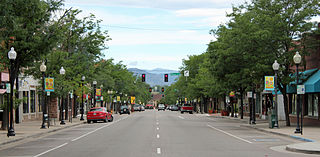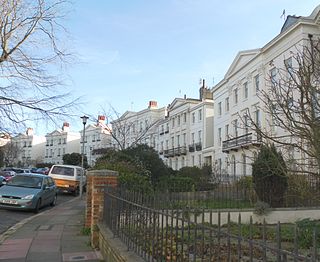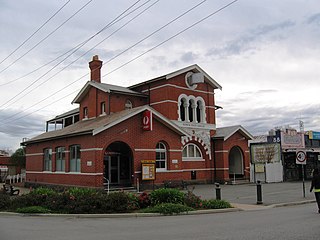| Geelong Synagogue | |
|---|---|
| Religion | |
| Affiliation | Judaism (former) |
| Ecclesiastical or organisational status |
|
| Year consecrated | 1861 |
| Status |
|
| Location | |
| Location | McKillop Street, Geelong, Victoria |
| Country | Australia |
| Architecture | |
| Architect(s) | John Young |
| Type | Italianate architecture |
| Date established | 1861 |
| Groundbreaking | 22 July 1861 |
| Official name: Geelong Synagogue (former); Former Synagogue | |
| Type | State heritage (built) |
| Designated | 14 September 1995 |
| Reference no. | 3015 |
| Type | Synagogue |
| Category | Religion |
| Builders | Jones and Halpin |
The Geelong Synagogue is a former synagogue at the corner of McKillop and Yarra Streets, Geelong, Victoria, Australia. It was designed by John Young and built in 1861 by Jones and Halpin. It is no longer used as a synagogue, but has been refurbished and is in use as offices. It was listed on the Victorian Heritage Register on 14 September 1995. [1] [2]
The synagogue is a particularly distinctive and important architectural design, in the Italianate style and in the eclectic and diverse manner of the architect John Young. The building is of social importance as the Synagogue of Geelong and in the history of the Jewish community in the area. [2]
It is a comparatively early building in Geelong and is of some importance in the surrounding townscape. The structure exhibits a detailing which is uncommon in buildings of this period, including the detailing to the side bays and particularly the corner piers and the broken pediment with its heavy brackets above the semi-circular gable light. There is a stucco porch with distinctive and prominent classically derived details. The form of the round headed side windows is unusual and the glazing pattern distinctive. The interior is believed to be intact and is notable for its exposition of the architect styles used for buildings of the smaller religious congregations during the nineteenth century. [2]
The synagogue is a four bayed structure with gables to either end, an advancing stuccoed porch and an apse to the other end. The walls are stuccoed and the roof is of slate. The corners of the main facade feature prominent piers elaborately decorated with recessed shafts, prominent string courses and other mouldings, recessed panels and prominent and distinctive brackets supporting the broken pediment motif above. The porch is also stuccoed and features prominent quoins, bourgeois and architrave moulding, round headed paired entrance doors, string course on brackets and a parapet. Above the porch is a large semi-circular window with prominent key stone and architrave mouldings. The side walls are arranged with recessed panels about each round headed window, surmounted by large key-stones and brackets in the form of dentals. There is a string course beneath the windows which feature an elaborate pattern of glazing bars and coloured glass. The interior is restrained and the apse is framed by a circular arch on Corinthian based pilasters. The structure was built in 1861 to the designs of architects John Young and F. T. Honey, practising as Young and Honey and the builders were Jones and Halpin. The foundation stone was laid on 22 July 1861 and the Synagogue was consecrated on 1 December 1861. This building replaced an earlier wooden building erected at the corner of Yarra and McKillop Streets, Geelong, which was consecrated on 1 June 1854. The building is intact both externally and internally and is in good condition. [2]
The synagogue is a single-storey gabled building with an apsidal extension on the eastern gable end. The roof is of slate and the brick walls have been cement rendered. A rectangular, flat-roofed, porch extends westward from the main gable end. It is enframed in much the same way as entrance doors to early homes in Ohio in the United States. The raking cornice of the gable forms an overhanging eave and a broken horizontal cornice is supported on either side by a pier giving the impression of a pediment. The latter is emphasised by prominent modillions, which are also used below the projecting cornice of the porch. [2]
Within the tympanum is a Diocletian window, common in Palladian architecture, with a moulded architrave and keystone. The piers are astylar and though prominent are decorated in low relief. In plan form they resemble early nave piers of the Norman period. The engaged colonettes enframe a rectangular moulding with a central circle. This decorative element was commonly used in early Italian renaissance architecture as well as subsequent adaptations. The small circular reliefs used in the upper section of the pier are most unusual and may be simplified version of the patera, commonly used motifs in the Adam style. They have been replicated in an exceptional manner in the stained glass windows. [2]
The elevation of the porch is overwhelmed by quoining especially by the Gibbs surround of the round-arched entrance. Above the paired wooden doors is a plain fanlight with a Hebrew inscription. The side walls are externally divided into four bays by plain pilasters. Within each bay is a round-arched window with a sill course below and keystone above which is extended to a wide string course. The string course, with dentils below, runs the full length of the side walls. This is an element common to many of Young's works including the Golden Age and Argyle Hotels. An unusual decorative element, however, is the stepping of the string course to represent a capital on the pilasters. Together with the dentils it appears to be a representation of ionic volutes. Such a treatment of classical elements is not unusual in Young's work. [2]
Internally there is a curved stained wood ceiling with a semi circular cut-out to a low light to enter from the Diocletian window above the balcony. Below the balcony is a vestibule, a small room and the staircase. The building is slightly water damaged. At the time it was assessed for the former Register of the National Estate, the local Jewish community wished to demolish the building (which stands on a grant of Crown land) because of the cost of upkeep and the tiny congregation, so it was not used for other purposes. The building remains, has been refurbished, and is now being used as offices. [2]
Because Young built the first synagogue and the similarities in style with his other buildings the synagogue is attributed to Young alone (rather than Young and Honey). [2]

In architecture, a cornice is generally any horizontal decorative moulding that crowns a building or furniture element—for example, the cornice over a door or window, around the top edge of a pedestal, or along the top of an interior wall. A simple cornice may be formed with a crown, as in crown moulding atop an interior wall or above kitchen cabinets or a bookcase.
This page is a glossary of architecture.

Cannondale Historic District is a historic district in the Cannondale section in the north-central area of the town of Wilton, Connecticut. The district includes 58 contributing buildings, one other contributing structure, one contributing site, and 3 contributing objects, over a 202 acres (82 ha). About half of the buildings are along Danbury Road and most of the rest are close to the Cannondale train station .The district is significant because it embodies the distinctive architectural and cultural-landscape characteristics of a small commercial center as well as an agricultural community from the early national period through the early 20th century....The historic uses of the properties in the district include virtually the full array of human activity in this region—farming, residential, religious, educational, community groups, small-scale manufacturing, transportation, and even government. The close physical relationship among all these uses, as well as the informal character of the commercial enterprises before the rise of more aggressive techniques to attract consumers, capture some of the texture of life as lived by prior generations. The district is also significant for its collection of architecture and for its historic significance.

The John Michael Kohler House is an historic house listed on the National Register of Historic Places in Sheboygan, Wisconsin, United States. The house is currently a part of the John Michael Kohler Arts Center complex.

Remmel Apartments and Remmel Flats are four architecturally distinguished multiunit residential buildings in Little Rock, Arkansas. Located at 1700-1710 South Spring Street and 409-411 West 17th Street, they were all designed by noted Arkansas architect Charles L. Thompson for H.L. Remmel as rental properties. The three Remmel Apartments were built in 1917 in the Craftsman style, while Remmel Flats is a Colonial Revival structure built in 1906. All four buildings are individually listed on the National Register of Historic Places, and are contributing elements of the Governor's Mansion Historic District.

The Joshua Sears Building is a historic building in Kirkland, Washington, located at the northwest corner of Market Street and Seventh Avenue, Kirkland's historic commercial core. It was built in 1891 by Boston philanthropist and capitalist, Joshua Sears, who was heavily invested in Peter Kirk's Great Western Iron and Steel Company and was the town site's largest landowner. As a result of the Panic of 1893, the steel mill and the bank intended to occupy this building never opened but the Sears building survives today as a reminder of what might have been in Kirkland. It is an early example of Beaux-Arts architecture in the Northwest, where Victorian and Romanesque Revival styles were still predominant in commercial buildings. On August 3, 1982, it was added the National Register of Historic Places. In December 2015 the building was purchased by local attorney Simeon Osborn and his wife Monica Hart, who stated they plan to keep the current business and residential tenants.

The Delavan Terrace Historic District is located along the street of that name in Northwest Yonkers, New York, United States. It consists of 10 buildings, all houses. In 1983 it was recognized as a historic district and listed on the National Register of Historic Places.

The Littleton Main Street is a historic district located along W. Main Street, from South Curtice Street, to South Sycamore Street in Littleton, Colorado. The district dates from 1890. The nineteenth century buildings are red pressed brick, many with stone foundations and trim. These buildings replaced smaller frame structures from the pioneer era and proclaimed the success of their builders through solid construction and application of exterior ornament.

Montpelier Crescent is a mid 19th-century crescent of 38 houses in the Montpelier suburb of the English coastal city of Brighton and Hove. Built in five parts as a set-piece residential development in the rapidly growing seaside resort, the main part of the crescent was designed between 1843 and 1847 by prominent local architect Amon Henry Wilds and is one of his most distinctive compositions. Extra houses were added at both ends of the crescent in the mid-1850s. Unlike most other squares, terraces and crescents in Brighton, it does not face the sea—and the view it originally had towards the South Downs was blocked within a few years by a tall terrace of houses opposite. Montpelier was an exclusive and "salubrious" area of Brighton, and Montpelier Crescent has been called its "great showpiece". Wilds's central section has been protected as Grade II* listed, with the later additions listed separately at the lower Grade II. The crescent is in one of the city's 34 conservation areas, and forms one of several "outstanding examples of late Regency architecture" within it.

Block A of the Rockhampton Technical College is a heritage-listed technical college building at Bolsover Street, Rockhampton City, Rockhampton, Rockhampton Region, Queensland, Australia. It was designed by Thomas Pye and built in 1914. It is also known as Rockhampton College of T.A.F.E. and Rockhampton State High School and Technical College. It was added to the Queensland Heritage Register on 21 October 1992.

Corn exchanges are distinct buildings which were originally created as a venue for corn merchants to meet and arrange pricing with farmers for the sale of wheat, barley, and other corn crops. The word "corn" in British English denotes all cereal grains, such as wheat and barley. With the repeal of the Corn Laws in 1846, a large number of corn exchanges were built in England, particularly in the corn-growing areas of Eastern England.

Cobar Post Office is a heritage-listed post office at 47 Linsley Street, Cobar, New South Wales, Australia. It was designed by James Barnet in 1885. It was added to the Australian Commonwealth Heritage List on 22 August 2012.

Temora Post Office is a heritage-listed post office at 173 Hoskins Street, Temora, New South Wales, Australia. It was added to the Australian Commonwealth Heritage List on 8 November 2011.

Cronulla Post Office is a heritage-listed post office at 41 Cronulla Street, Cronulla, Sydney, New South Wales, Australia. It was designed by Edwin Hubert Henderson of the Commonwealth Department of Works and Railways and built in 1924. It was added to the Australian Commonwealth Heritage List on 22 August 2012.

Bowen Post Office is a heritage-listed post office at 46 Herbert Street, Bowen, Queensland, Australia. It was designed by the Commonwealth Department of the Interior and constructed in 1936. It was added to the Australian Commonwealth Heritage List on 8 November 2011.

Stanthorpe Post Office is a heritage-listed post office at 14 Maryland Street, Stanthorpe, Southern Downs Region, Queensland, Australia. It was designed by John Smith Murdoch of the Queensland Government Architect's office and was built by D. Stewart and Co in 1901. It was added to the Australian Commonwealth Heritage List on 22 June 2004.

Ingham Post Office is a heritage-listed post office at 15 Lannercost Street, Ingham, Shire of Hinchinbrook, Queensland, Australia. It was built in 1935. It was added to the Australian Commonwealth Heritage List on 22 August 2012.

Euroa Post Office is a heritage-listed post office at 90 Binney Street, Euroa, Victoria, Australia. It was designed by John Thomas Kelleher of the state Public Works Department, possibly with the assistance of A. J. McDonald, and built in 1890 by George Diggle. It was added to the Australian Commonwealth Heritage List on 22 August 2012.

Lloyd Square, a garden square in Clerkenwell, central London, It consists of Grade II Listed houses making up a square of unique and noted character in central London. Its nearest tube stations are Kings Cross, Russell Square, Farringdon, Angel and Chancery Lane. The square has mature trees, flowers, beds and shrubs and is lined by neat hedges and formal railings, which are listed.

North Hobart Post Office is a heritage-listed post office at 412-414 Elizabeth Street, North Hobart, Tasmania, Australia. It was added to the Australian Commonwealth Heritage List on 8 November 2011.
![]() This article incorporates text available under the CC BY 3.0 AU licence.Required attribution: © Commonwealth of Australia 2013.
This article incorporates text available under the CC BY 3.0 AU licence.Required attribution: © Commonwealth of Australia 2013.